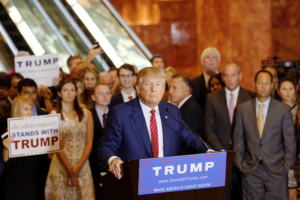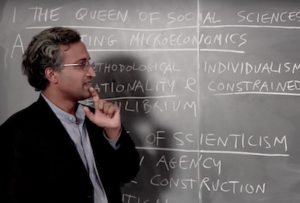As we argued in the case of consumer theory, the noteworthy primary results of the standard theory of the firm (such as Hotelling’s Lemma or Shephard’s Lemma, the negative incremental effect of an increase in the price of a factor of production on conditional demand for that same factor, and the symmetry of the incremental effects of an increase in the price of a factor on the conditional demand for another factor) are almost immediate consequences of the very description of firms as maximizing profits (understood as a real valued function of input and output prices, given technology).
Once more, the description (hardly very fleshy) is the theory (sufficient, even without adding any auxiliary hypotheses, to provide to us rather many of its supposed jewels). In short, none of the results are in the least surprising.
Does this show that the theory is (as is sometimes argued) ‘general’ or rather that it is empty? Does it show that a mathematical formulation can be illuminating or that one can provide a detailed mathematical redescription of a concise linguistic proposition (in this case the idea that agents, be they firms or consumers, maximize something)? [Even this characterization appears more innocent than it is. One can think of the robust tradition (e.g. in the work of Veblen (1904), Berle and Means (1932), Galbraith (1967) and others since) of describing firms as being run for purposes other than the maximization of profits, the evolutionary and behavioral tradition which emphasizes the sufficiency of satisficing and other non-maximizing behaviors (e.g. in the work of Simon (1958) or Nelson and Winter (1985)) and more recently the body of reasoning which emphasizes the importance of survival constraints (and relatedly, debt minimization rather than profit maximization) in understanding firm’s responses to shocks in a crisis situation marked by excessive aggregate debt (on the general issue see Mehrling (2010) and on debt minimization to enable firm survival in the context of a ‘balance sheet recession’ see the recently popular work of Koo (2011).]
Although the text devotes much less space to developing the theory of the firm than it does to developing the theory of the consumer, its claims in relation to the former are bolder:
“Many aspects enter a full description of a firm: Who owns it? Who manages it? How is it managed? How is it organized? What can it do? Of all these questions, we concentrate on the last one. Our justification is not that the other questions are not interesting (indeed, they are), but that we want to arrive as quickly as possible at a minimal conceptual apparatus that allows us to analyze market behavior. Thus, our model of production possibilities is going to be very parsimonious: The firm is viewed merely as a “black box”, able to transform inputs into outputs.”
The claim that the framework presented is ‘parsimonious’ suggests the idea that it does what is needed (creates a ‘minimal conceptual apparatus that allows us to analyze market behavior’) with little by way of premises. However, most of the theory presented in the chapter does nothing but reiterate (in different, more mathematical form) the statement (or should we say conjecture?) that firms maximize profits subject to constraints of given technology and prices.
The authors themselves begin the paragraph with a series of pertinent questions (which do not exhaust the range of questions which one might ask[1]), and which they then proceed to admit they will not answer. Yet, they claim to be able to ‘analyze market behavior’ — a fairly substantial goal. One might be forgiven for viewing this as a case of rhetorical slippage (bloat?).[2]
The chapter does include contents which go beyond this redescription, notably in the discussion of properties of technologies (such as economies or diseconomies of scale) and of the ‘linear activity model’[3]. What contribution to our understanding of the theory of the firm does each of these discussions make?
The development of a theory of production sets provides descriptive concepts (in particular counterfactual ideas such as increasing, decreasing and constant returns to scale) which may be fruitfully used to characterize input-output relationships (‘technology’) notwithstanding quibbles which can be made (and the famous effort of Piero Sraffa to avoid counterfactual reasoning altogether, on which more anon). The ideas presented in this regard may come as close to a ‘general’ framework which is relatively untethered to a specific set of behavioral premises as has yet been encountered in the text. Section 5.B in particular describes these properties and their logical relationships.
Such concepts may be useful to draw upon in characterizing the world, even where they do not apply without qualification. Indeed some of these concepts (e.g. free disposal, free entry or the idea that a particular kind of economy of scale is a global property of a production function) are often patently at odds with economic facts. However, the very negation of their empirical validity (e.g. the statement that ‘free entry does not exist in the market for widgets’) may help in generating valuable empirical descriptions. [The text unnecessarily emphasizes the rather narrow lens that they are ‘commonly assumed properties’ (p. 127), a characterization which seems to foreground disciplinary sociology over considerations of realism.]
The Appendix of Chapter 5 is one of the most curious sections of the entire textbook. It motivates the ‘linear activity model’ which it introduces on the grounds (1) of the ‘saliency of the model of production with convexity and constant returns to scale technologies’ and (2) that the special case of the linear activity model ‘lends itself to explicit computation and is therefore very important in applications’. The economists cited in the chapter are Leontieff, Samuelson and Gale. Not a hint is given of the real historical motivation for and origins of the linear activity model in the tradition of classical political economy.
The model (including the famed non-substitution theorem of Paul Samuelson, discussed in the appendix) captures the conditions for the validity of an idea formulated by the classical economists: if labor is a fundamental generative factor required for the production of all commodities, in a setting in which constant returns to scale prevail (the ‘long run’) prices are determined by technological factors alone, and demand is relevant only to the determination of the pattern of production, with no changes in the techniques employed in production ever entailed.
This classical idea was given further justification and generality (notably by not requiring the assumption of constant returns to scale or any other counterfactual assumptions) by Piero Sraffa, who demonstrated that it is possible to establish an account of prices (and the rate of surplus, to be divided between profits and wages on the basis of exogenous factors) as determined by technological factors alone (see e.g. Sen (2003) and Sinha (2009)). In different ways, Samuelson and Sraffa showed that ‘modern’ methods could remarkably confirm and extend the insights of the classical political economists, while establishing the specific conditions required for their validity. Samuleson explicitly, and at length, provided motivation and interpretation related to the concerns of the classical political economists (especially Ricardo) in his presentation of the non-substitution theorem (see Samuelson, 1959a and 1959b).
The glaring omission of any mention of the historical origins and interpretative significance of the ‘linear activity model’ is not merely a case of Hamlet without the Prince, but is analogous to thinking of the oeuvre of Shakespeare in terms of the few lines of his plays have been cited in recent films. Students can be forgiven for thinking that the Appendix can be skipped, in light of the authors’ failure to explain why one ought to care a whit about it. There are reasons that the classical political economists were interested in the ‘linear activity’ framework, but it appears that the authors of the text do not think it important to mention them.
One need not believe that the classical political economists were ‘right’ in order to think that it is a gross intellectual error to neglect the substantive motivation and interpretation of a model deriving from their preoccupations (over a century). Sadly, the cost of collective amnesia may be great.
References
Berle, A and G. Means (1932), The Modern Corporation and Private Property, Transaction Publishers (reprinted ,1991).
Galbraith, J.K. (1967, new edition 2007), The New Industrial State, Princeton: Princeton University Press.
Koo, R (2011), “The world in balance sheet recession: causes, cure, and politics”, real-world economics review (issue no. 58).
Mehrling, P. (2010), The New Lombard Street: How the Fed Became the Dealer of Last Resort, Princeton: Princeton University Press.
Nelson, R.R. and S.G. Winter (1985), An Evolutionary Theory of Economic Change, Cambridge, MA: Belknap Press of Harvard University Press.
Samuelson, P. (1959a), “A Modern Treatment of the Ricardian Economy: I. The Pricing of Goods and of Labor and Land Services”, Quarterly Journal of Economics, 73 (1): 1-35.
Samuelson, P. (1959b), “A Modern Treatment of the Ricardian Economy: II. Capital and Interest Aspects of the Pricing Process”, Quarterly Journal of Economics, 73 (2): 217-31.
Sen, A. (2003). “Sraffa, Wittgenstein, and Gramsci”. Journal of Economic Literature, 41(4): 1240-1255.
Simon, H. A. (1957). Models of Man: Social and Rational. New York: Wiley
Sinha, A. (2010). Theories of Value from Adam Smith to Piero Sraffa. London: Routledge.
Veblen, T. (1904). The Theory of Business Enterprise, Jepson Press (republished 2011).
[1] Among the questions left out concern, for instance, that of how firms arrive at and develop ways of doing things (‘technology’) over time, and that of how the asymmetrical relations between labor, managers and owners of capital shape the firm. We also alluded to these issues briefly in the previous post referred to in the first paragraph.
[2] In section 5.G the authors discuss the logical sustainability and empirical realism of the assumption of profit maximization in light of the theoretical premise that utility maximization is the more fundamental postulate and the acknowledgment that there could be various reasons for profit maximization to fail. This is a rare instance within the text of a case of effort to address correspondence between theory and muddy reality, but the exercise appears to be motivated by the need to resolve a potential theoretical inconsistency (between the assumptions of utility and profit maximization).
[3] The discussion in section 5.F of the relationship between profit maximization and efficiency can be viewed as part of the redescription.





